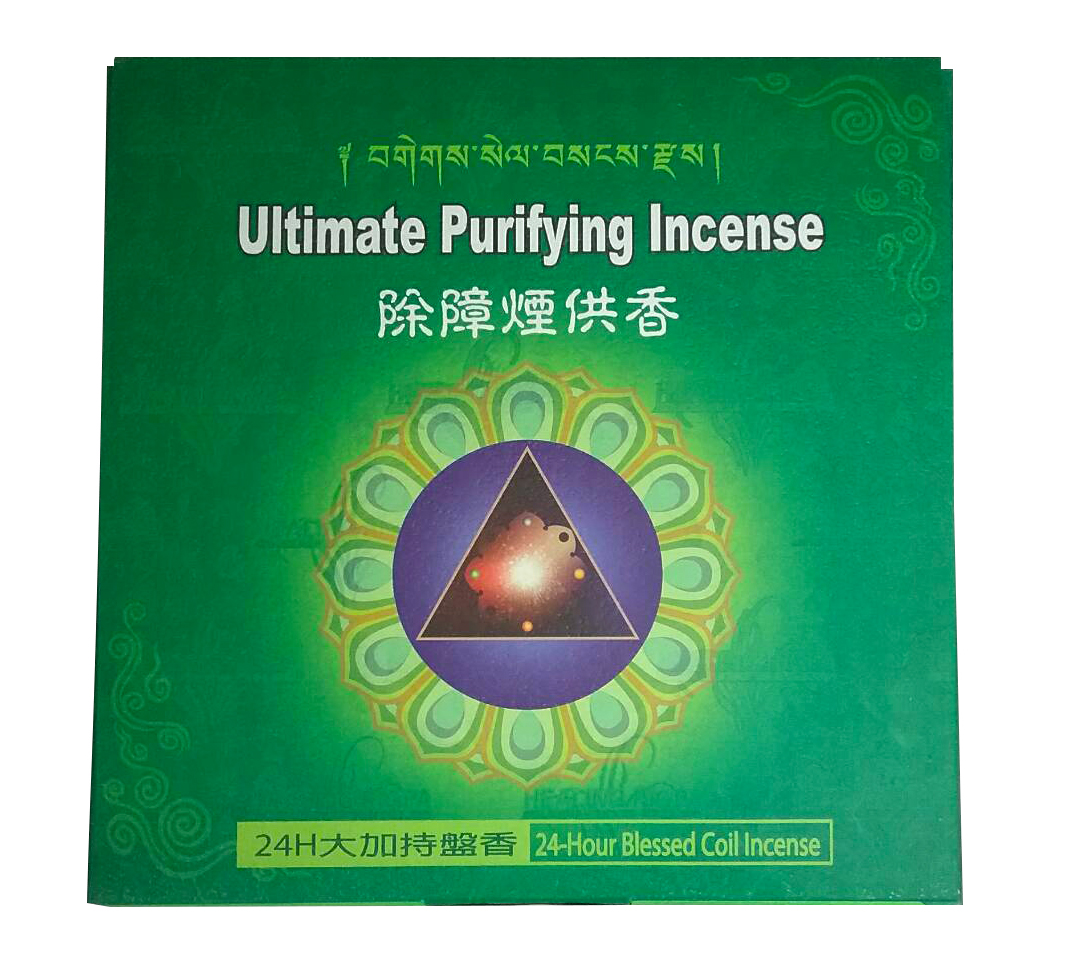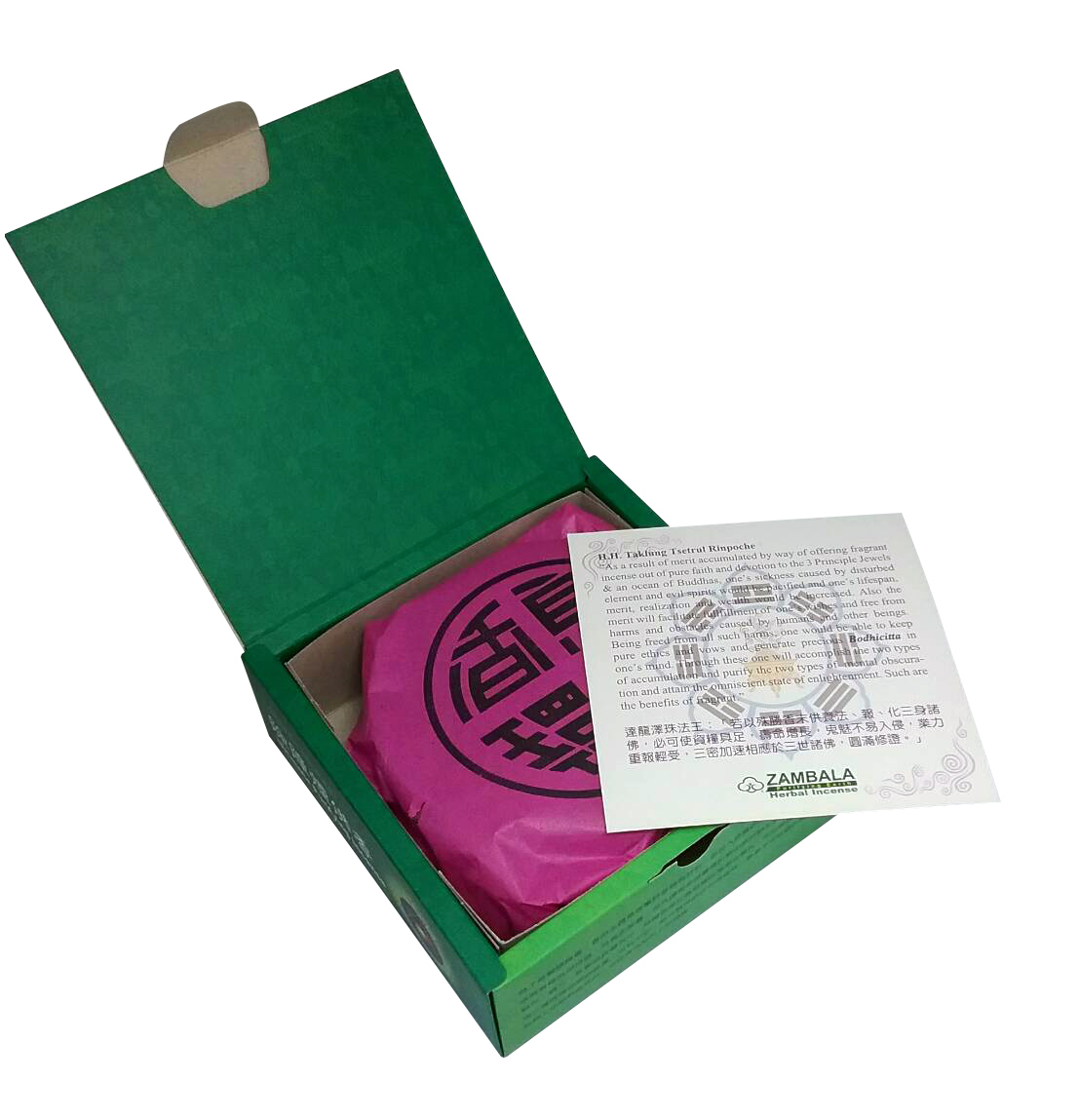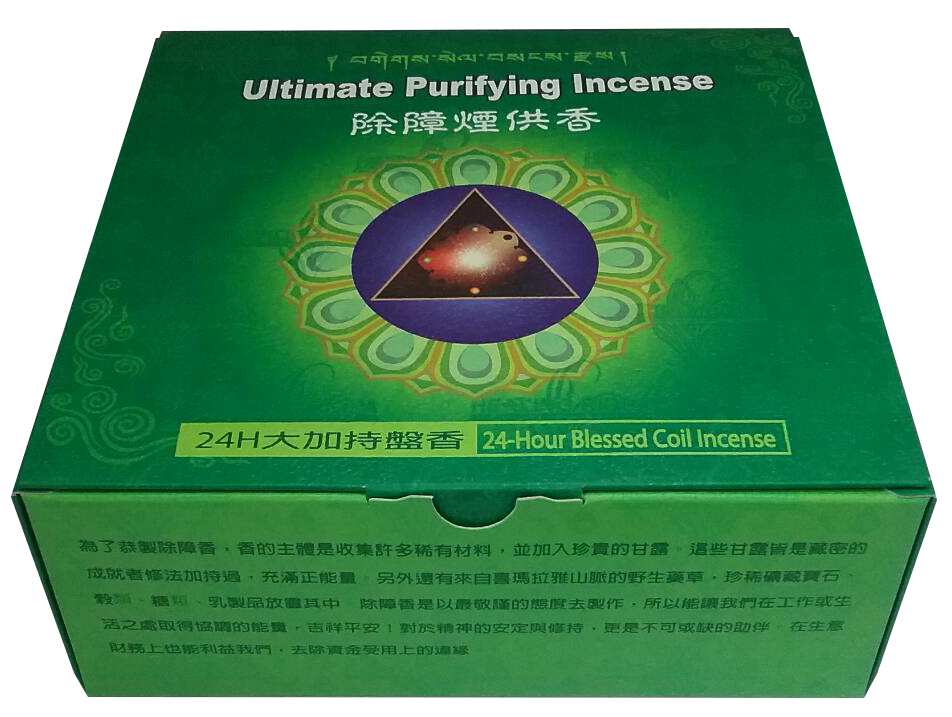|
|
|
Wholesalers: |

|
/ |
|
|
|
|
|
|
|
|
| "Teach this triple truth to all: A generous heart, kind speech, and a life of service and compassion are the things which renew humanity."
~The Buddha |
|
|
|
|
|
|
|
|
|
|
|
|
|
|
|
|
|
|
|
| Purifying Coil Incense (24 Hrs) |
|
|
|
|
|
Sku#:3151
|
|
《In order to view the wholesale price .
Please Apply to be a wholesalers》
|
|
|
|
|
 |
|
Please contact us to verify availability. 1-626-354-6228
Email: zambalallc@gmail.com
America area customers can view on this website first.
https://FlyingMystics.org/ |
|
|
|
|
|
|
Materials: Herbs and medicinal materials, rare minerals, nectar, rare incense materials
Size: Net weight: 328 grams
Description:
[Obstacle-Removing Incense]
To create this obstruction-removing incense, we collected numerous rare materials and infused it with precious nectar, blessed by accomplished Tibetan masters and imbued with positive energy. Wild herbs from the Himalayas, rare minerals, gemstones, grains, sugars, and dairy products are also incorporated. This obstruction-removing incense is crafted with the utmost respect and dedication. It can bring harmonious energy and peace to our work and lives! It is essential for spiritual stability and spiritual practice. It can also benefit our business and finances, removing obstacles to financial well-being.
Obstacle-removing incense (also known as purifying incense or Tibetan lying incense) is an essential spiritual tool in Buddhist rituals, particularly those of Tibetan Buddhism. Its core function is to generate smoke through burning, enabling the practice of "Sang Offering." This practice emphasizes "offerings to the Buddhas and Bodhisattvas above, and giving to all sentient beings in the six realms below." This means offering to the Three Jewels (Buddha, Dharma, and Sangha) above and to all sentient beings, including ghosts, spirits, and enemies and creditors, thereby accumulating merit and dispelling karmic obstacles. In specific rituals, incense for removing obstacles plays the following key roles:
1. **Purifying the Environment and Magnetic Field**: It is often used in the "Purifying the Mandala" ceremony at the beginning of a Dharma ceremony, before the installation of a Buddha statue, or during the cleansing process after moving into a new home or visiting graves. The smoke dispels foul air, disease, and negative energy, stabilizing the energy in the space and preventing interference from demons and external forces, ensuring a smooth and successful ritual.
2. **Assisting Meditation and Sitting Meditation**: During meditation or concentration, the aroma of incense for removing obstacles helps remove internal obstacles (such as distracting thoughts and karma) and external obstacles (such as environmental disturbances), enhancing concentration, calming the mind, replenishing vital energy, and promoting smooth flow of qi and meridians. It is particularly suitable for beginners or those with distracted minds.
3. **Offering and Prayer**: Burning incense during ceremonies, prayers for the deceased, or to express gratitude to the gods can dedicate merit, resolve old grudges, eliminate negative karma, and bring peace to the home, success in career, and the transformation of misfortune into good fortune. Smoke offerings are often accompanied by mantras, mudras, and blessings to amplify their spiritual effects.
4. **Daily Protection and Evil Abjuration**: Incense is not limited to temple ceremonies but is also incorporated into home practices. For example, it can be used to calm the mind before bed, to resolve negative influences such as Tai Sui, or to treat long-term illnesses. It is considered a "personal treasure," protecting the home from harm caused by celestial beings, earthly spirits, or enemies and creditors.
Overall, barrier-removing incense is more than just a physical incense; it symbolizes the Buddhist principles of "cause and effect" and "compassion and universal salvation." Through the diffusion of its smoke, it embodies the vast merit of "one incense, one universal fragrance."
The Origin of Barrier-Removing Incense
The origins of barrier-removing incense can be traced back to the early Buddhist tradition of smoke offerings, a tradition with a long history and close ties to the tantric practices of Tibetan Buddhism. The practice of incense offerings dates back to the time of the Buddha (circa 5th century BC). It was used for offerings and incense burning, aiming to prove the existence of the Dharma and benefit sentient beings. However, its development as a specialized incense for removing obstacles stems primarily from the 8th century Tibetan Buddhist tradition.
- **Historical Background**: After Songtsen Gampo unified Tibet in the 7th century, Buddhism began to spread to the Tibetan Plateau. In the early 8th century, Trisong Detsen further promoted Buddhism by inviting the Indian monk Padmasambhava (also known as Guru Padmasambhava) to Tibet. When Guru Padmasambhava established Samye Monastery on the north bank of the Yarlung Zangbo River, he faced strong resistance from local gods and demons and introduced the incense burning ritual as a practical method for subduing demonic obstacles. This tradition primarily uses cypress wood, which grows on the Tibetan plateau and emits a unique fragrance when burned. Later, Thonmi Sambhota brought the production techniques back from India and promoted them in the Thonba River Valley, using waterwheels to grind the cypress wood into incense bricks. Tibetan incense thus became an indispensable element in temples, gradually evolving into "obstacle-removing incense." It contains precious medicinal herbs such as white sandalwood, agarwood, and purple agarwood, infused with relic nectar and the blessings of the guru.
- **Classical Reference**: Its formula originates from the "Blue Divine Water Purifying and Removing Impurities Smoke Sutra" (also known as the "Smoke Removing Impurities Smoke Sutra"), a Buddhist text taught by Guru Padmasambhava. This text emphasizes the ability of incense to eliminate obstacles such as malevolent spirits above, evil dragons below, and mountain and water monsters in the inner realms. Later, it was blessed by the exoteric and esoteric monastic community, becoming a precious sacred item and widely circulated within the Nyingma and other schools of Tibetan Buddhism.
In the Chinese-speaking world, obstacle-removing incense became popular in the late 20th century with the eastward spread of Tibetan Buddhism. It is commonly found in spiritual communities in Taiwan and China, blending Han and Tibetan elements and used for daily prayers.
Stories Related to Obstacle-Removing Incense
The legends and stories surrounding obstacle-removing incense often revolve around Guru Padmasambhava's feats of subduing demons, demonstrating his miraculous ability to transform impurities into purity. The following are two representative stories:
1. The Legend of Guru Rinpoche's Subjugation of Tibetan Gods and Demons: In the 8th century, Guru Rinpoche entered Tibet at the invitation of Trisong Detsen to build Samye Monastery. He encountered intense interference from local spirits and ghosts: raging storms, frequent earthquakes, and even mountain and water monsters transformed into ferocious beasts that obstructed the project. Guru Rinpoche observed the cause and concluded it was the work of ghosts and demons. He then performed a smoke offering based on the Generation Stage Tantra. He used cypress wood and precious spices to create incense, chanted mantras (such as Guru Rinpoche's heart mantra, "Om Ah Hum Benza Guru Pema Siddhi Hum"), and used hand seals to bless it. Upon lighting the incense, plumes of smoke rose. He offered it to the Buddhas and Bodhisattvas, requesting their blessings, and to the ghosts and demons, regarding the smoke as an offering and asking them to depart. The ghosts, delighted by the incense, retreated, and the temple was successfully completed. This incident not only dispelled local demonic obstacles but also made Tibetan incense a symbol of Tibetan Buddhism. Legend has it that Guru Rinpoche personally passed down the "Blue Divine Water Purifying Impurities Incense Smoke Sutra," instructing future generations on how to offer incense to the Buddha and dispel evil spirits, laying the foundation for the practice of barrier-removing incense. This story symbolizes the Buddhist wisdom of "compassion and transformation": resolving resentment through offerings rather than force, and is still frequently recited in Tibetan ceremonies.
2. **Modern Miraculous Story: Encountering Ghosts on a Film Set**: A Buddhist filmmaker frequently encountered "unclean beings" (such as ghosts or spirits) on location. These caused camera malfunctions, flickering lights, and even actors to become disoriented, resulting in numerous delays. Later, he received instruction from his master in the "Portable Treasure Barrier-Removing Incense." He burned incense on location, filling the air with smoke and chanting a dedication mantra. A miracle occurred: the equipment returned to normal, the atmosphere on set was refreshed, and the distractions vanished, allowing filming to proceed smoothly. This incident is considered a contemporary testament to the effectiveness of purifying incense, highlighting its effectiveness in dispelling ghosts of past life vows and other obstacles, and encouraging its daily use by believers.
These stories not only enrich the cultural significance of purifying incense but also highlight its continuity from ancient times to modern times, reminding practitioners that even a small incense stick can bring immeasurable merit, and the key lies in sincere devotion.
Storage: Keep in a cool, dry place.
Shelf Life: Indefinite if properly stored..jpeg) 


|
|
|
|
|
|
|
|
 |
|
|
|
|
|
|
|
|
|
|
|
|
|
|
|
|
© 2025 Zambala inc. All Rights Reserved. No part of this site may be reproduced without our written Permission.
Service Mail: ZambalaLLC@gmail.com
Phone: (626) 289-9787 or 1(888)Zambala (926-2252)
Fax: (626) 289-9719
1904 West Valley Blvd. Alahambra, CA 91803 USA
Unless stated otherwise in content's license. Design By
|
|
|